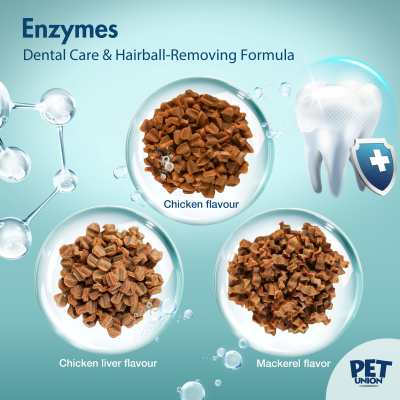Effective Cat Dental Treats: The Ultimate Guide to Ingredients & Textures for Oral Hygiene
Cats are masters of hiding discomfort, but poor oral health can silently impact their quality of life—from bad breath and gum irritation to serious issues like tooth decay or infection. While regular vet checkups are key, dental treats designed for cats can be a game-changing part of their oral care routine. But not all dental treats are created equal. Let’s break down why cats need dental treats, how they work, and what to look for in effective options—with a focus on ingredients and textures that deliver real results.
Do Cats Need Dental Treats?
Short answer: Yes, but they’re not a replacement for full dental care. Cats’ teeth, like humans’, accumulate plaque and tartar over time. Left unchecked, this can lead to gingivitis, tooth loss, or even systemic health issues.
Dental treats aren’t just “snacks”—they’re functional tools. They complement at-home care (like brushing, if your cat tolerates it) and vet cleanings by reducing plaque buildup between visits. For cats who hate toothbrushes (let’s be real, most do!), dental treats offer a stress-free way to support oral health.
Are Cat Dental Treats Effective? How Do They Work?
The best cat dental treats work through a combination of active ingredients and smart textures, targeting plaque, bacteria, and bad breath at the source. Let’s dive into how each component delivers results.
1. Active Ingredients: Fighting Bacteria from Within
Effective dental treats go beyond “crunchy”—they’re formulated with ingredients that actively combat oral bacteria and debris. One standout example is Pet Union’s Feline Dental Treats Mackerel and Chicken Flavor Enzymatic Cat Chews, powered by patented A.E.BioDent® enzymes.

These enzymes work in four key ways:
- Inhibit Bacteria: They target the harmful bacteria that cause plaque and gum inflammation, reducing the risk of gingivitis.
- Break Down Food Residues: Enzymes dissolve leftover food particles stuck between teeth, preventing tartar buildup.
- Freshen Breath: By reducing volatile sulfur compounds (VSCs)—the smelly byproducts of bacteria—they eliminate bad breath at its source (not just mask it).
- Safe for Daily Use: Unlike harsh chemicals, these enzymes are gentle enough for daily feeding, making consistent care easy.
Why it matters: Enzymatic treats turn snack time into a “deep clean,” working even when your cat isn’t actively chewing.
2. Smartly Abrasive Textures: Scraping Away Plaque
Texture is just as critical as ingredients. A treat’s crunch or texture physically scrapes plaque and tartar off teeth as your cat chews—like a mini toothbrush in every bite.

Take Pet Union’s Teeth Cleaning Cat Treats for Breath Crunchy Bites with Catnip as an example. These treats feature a chewy texture with porous surfaces that:
- Mechanically Removes Plaque: The porous crunch scrapes away soft plaque from tooth surfaces during cats’ teeth sinking in, preventing it from hardening into tartar.
- Encourages Chewing: The addition of catnip makes these treats irresistible, ensuring your cat chews thoroughly (maximizing the cleaning effect).
- Boosts Freshness Naturally: Infused with cranberry and green tea extract, they add extra breath-freshening power and antioxidants to support gum health.
Pro tip: Look for treats with varied textures (crunchy, ridged, or slightly chewy) to target different areas of the mouth—front teeth, molars, and gum lines.
How Often Should You Feed Your Cat Dental Treats?
Consistency is key! Most dental treats are designed for daily feeding, but always check the package instructions. For example:
– Enzymatic treats like the mackerel-chicken chews can be fed 1–2 times daily (follow weight-based guidelines).
– Crunchy texture treats (like the catnip bites) can also be given daily, as part of a balanced diet.
Note: Dental treats should make up no more than 10% of your cat’s daily calories to avoid overfeeding. Pair them with a high-quality main diet for balanced nutrition.
Are Dental Treats Enough for Cats’ Oral Health?
While dental treats are effective, they’re not a standalone solution. Think of them as part of a “dental care toolkit.” For optimal oral health, combine treats with:
- Regular Vet Exams: Annual dental checkups (or more for senior cats) let vets spot early signs of issues and perform professional cleanings when needed.
- At-Home Brushing: If your cat tolerates it, brushing 2–3 times per week with cat-specific toothpaste is the gold standard for plaque prevention.
- Water Additives or Mouthwashes: Vet-approved formulas can reduce bacteria in hard-to-reach areas.
Dental treats shine as a convenient, low-stress way to maintain results between these more intensive care steps.
Other Dental Care Tools for Cat Oral Health
To round out your cat’s oral care routine, consider these tools alongside dental treats:
Dental Toys: Rubber or loofah toys with textured surfaces let cats “brush” while playing.
Dental Wipes: For cats who hate brushes, gentle wipes can clean teeth and gums quickly.
Prescription Diets: Some vet-formulated diets are designed to reduce tartar with special kibble shapes or ingredients—ask your vet if they’re right for your cat.
Final Thoughts: Choose Treats That Work Harder
Not all cat dental treats are created equal. The most effective options combine active ingredients (like enzymes) to fight bacteria and smart textures to scrape plaque, making snack time a powerful part of your cat’s oral care routine.
For results you can trust, try Pet Union’s dental treat lineup:
- Enzymatic Chews (mackerel & chicken flavor) for daily bacterial defense
- Crunchy Catnip Bites for texture-based cleaning and fresh breath
Your cat’s smile (and fresh breath!) will thank you.
